Metal Ion Microwave-Assisted Depolymerization of Poly(Ethylene Terephthalate): A Zinc Salts-Based Deep Eutectic Solvent as Case Study
Abstract
:1. Introduction
2. Materials and Methods
2.1. DES and PET Flakes Preparation
2.2. Microwave Treatments
2.3. Equipment and Methods
3. Results and Discussion
3.1. PET Flakes Weight
3.2. XRD
3.3. IR Spectroscopy Study
3.4. SEM Study of Recovered Flakes
3.5. NMR
3.6. Hypothesis of Reaction Mechanism
4. Conclusions
Author Contributions
Funding
Data Availability Statement
Acknowledgments
Conflicts of Interest
References
- Chen, L.; Pelton, R.E.O.; Smith, T.M. Comparative Life Cycle Assessment of Fossil and Bio-Based Polyethylene Terephthalate (PET) Bottles. J. Clean. Prod. 2016, 137, 667–676. [Google Scholar] [CrossRef]
- Arena, U.; Mastellone, M.L.; Perugini, F. Life Cycle Assessment of a Plastic Packaging Recycling System. Int. J. Life Cycle Assess. 2003, 8, 92. [Google Scholar] [CrossRef]
- Gomes, T.S.; Visconte, L.L.Y.; Pacheco, E.B.A.V. Life Cycle Assessment of Polyethylene Terephthalate Packaging: An Overview. J. Polym. Environ. 2019, 27, 533–548. [Google Scholar] [CrossRef]
- Qualities of Common Plastic Bottle Materials. Available online: https://www.usplastic.com/knowledgebase/article.aspx?contentkey=1001 (accessed on 9 April 2024).
- Comprehensive Guide on Polyethylene (PE). Available online: https://omnexus.specialchem.com/selection-guide/polyethylene-plastic%23tubing (accessed on 9 April 2024).
- Garcia, J.M.; Robertson, M.L. The Future of Plastics Recycling. Science 2017, 358, 870–872. [Google Scholar] [CrossRef]
- Alzlzly, K.R.H. Recycling and Its Role in Reducing Costs and Achieving Sustainability. In AIP Conference Proceedings; AIP Publishing: Melville, NY, USA, 2023; p. 100001. [Google Scholar]
- Zichittella, G.; Ebrahim, A.M.; Zhu, J.; Brenner, A.E.; Drake, G.; Beckham, G.T.; Bare, S.R.; Rorrer, J.E.; Román-Leshkov, Y. RETRACTED: Hydrogenolysis of Polyethylene and Polypropylene into Propane over Cobalt-Based Catalysts. JACS Au 2022, 2, 2259–2268. [Google Scholar] [CrossRef]
- King, S. Recycling Our Way to Sustainability. Nature 2022, 611, S7. [Google Scholar] [CrossRef]
- PET Market In Europe: State Of Play 2022. Available online: https://eunomia.eco/reports/pet-market-in-europe-state-of-play-2022/ (accessed on 17 April 2024).
- Directive (EU) 2019/904 of the European Parliament and of the Council of 5 June 2019 on the Reduction of the Impact of Certain Plastic Products on the Environment (Text with EEA Relevance). Official Journal of the European Union. Available online: https://eur-lex.europa.eu/eli/dir/2019/904/oj (accessed on 17 April 2024).
- Brivio, L.; Tollini, F. PET Recycling: Review of the Current Available Technologies and Industrial Perspectives. Adv. Chem. Eng. 2022, 60, 215–267. [Google Scholar]
- Schyns, Z.O.G.; Shaver, M.P. Mechanical Recycling of Packaging Plastics: A Review. Macromol. Rapid Commun. 2021, 42, 2000415. [Google Scholar] [CrossRef]
- Ragaert, K.; Delva, L.; Van Geem, K. Mechanical and Chemical Recycling of Solid Plastic Waste. Waste Manag. 2017, 69, 24–58. [Google Scholar] [CrossRef]
- Al-Sabagh, A.M.; Yehia, F.Z.; Eshaq, G.; Rabie, A.M.; ElMetwally, A.E. Greener Routes for Recycling of Polyethylene Terephthalate. Egypt. J. Pet. 2016, 25, 53–64. [Google Scholar] [CrossRef]
- Jeswani, H.; Krüger, C.; Russ, M.; Horlacher, M.; Antony, F.; Hann, S.; Azapagic, A. Life Cycle Environmental Impacts of Chemical Recycling via Pyrolysis of Mixed Plastic Waste in Comparison with Mechanical Recycling and Energy Recovery. Sci. Total Environ. 2021, 769, 144483. [Google Scholar] [CrossRef]
- Ragaert, K.; Huysveld, S.; Vyncke, G.; Hubo, S.; Veelaert, L.; Dewulf, J.; Du Bois, E. Design from Recycling: A Complex Mixed Plastic Waste Case Study. Resour. Conserv. Recycl. 2020, 155, 104646. [Google Scholar] [CrossRef]
- Tomás, R.A.F.; Bordado, J.C.M.; Gomes, J.F.P. P-Xylene Oxidation to Terephthalic Acid: A Literature Review Oriented toward Process Optimization and Development. Chem. Rev. 2013, 113, 7421–7469. [Google Scholar] [CrossRef]
- Damayanti; Wu, H.-S. Strategic Possibility Routes of Recycled PET. Polymers 2021, 13, 1475. [Google Scholar] [CrossRef]
- Barnard, E.; Rubio Arias, J.J.; Thielemans, W. Chemolytic Depolymerisation of PET: A Review. Green. Chem. 2021, 23, 3765–3789. [Google Scholar] [CrossRef]
- George, N.; Kurian, T. Recent Developments in the Chemical Recycling of Postconsumer Poly(Ethylene Terephthalate) Waste. Ind. Eng. Chem. Res. 2014, 53, 14185–14198. [Google Scholar] [CrossRef]
- Paparella, A.N.; Perrone, S.; Salomone, A.; Messa, F.; Cicco, L.; Capriati, V.; Perna, F.M.; Vitale, P. Use of Deep Eutectic Solvents in Plastic Depolymerization. Catalysts 2023, 13, 1035. [Google Scholar] [CrossRef]
- Yue, Q.F.; Wang, C.X.; Zhang, L.N.; Ni, Y.; Jin, Y.X. Glycolysis of Poly(Ethylene Terephthalate) (PET) Using Basic Ionic Liquids as Catalysts. Polym. Degrad. Stab. 2011, 96, 399–403. [Google Scholar] [CrossRef]
- Wang, Q.; Geng, Y.; Lu, X.; Zhang, S. First-Row Transition Metal-Containing Ionic Liquids as Highly Active Catalysts for the Glycolysis of Poly(Ethylene Terephthalate) (PET). ACS Sustain. Chem. Eng. 2015, 3, 340–348. [Google Scholar] [CrossRef]
- Wang, Y.; Zhang, Y.; Song, H.; Wang, Y.; Deng, T.; Hou, X. Zinc-Catalyzed Ester Bond Cleavage: Chemical Degradation of Polyethylene Terephthalate. J. Clean. Prod. 2019, 208, 1469–1475. [Google Scholar] [CrossRef]
- Al-Sabagh, A.M.; Yehia, F.Z.; Eissa, A.-M.M.F.; Moustafa, M.E.; Eshaq, G.; Rabie, A.-R.M.; ElMetwally, A.E. Glycolysis of Poly(Ethylene Terephthalate) Catalyzed by the Lewis Base Ionic Liquid [Bmim][OAc]. Ind. Eng. Chem. Res. 2014, 53, 18443–18451. [Google Scholar] [CrossRef]
- Zhu, M.; Li, Z.; Wang, Q.; Zhou, X.; Lu, X. Characterization of Solid Acid Catalysts and Their Reactivity in the Glycolysis of Poly(Ethylene Terephthalate). Ind. Eng. Chem. Res. 2012, 51, 11659–11666. [Google Scholar] [CrossRef]
- Geng, Y.; Dong, T.; Fang, P.; Zhou, Q.; Lu, X.; Zhang, S. Fast and Effective Glycolysis of Poly(Ethylene Terephthalate) Catalyzed by Polyoxometalate. Polym. Degrad. Stab. 2015, 117, 30–36. [Google Scholar] [CrossRef]
- Fang, P.; Liu, B.; Xu, J.; Zhou, Q.; Zhang, S.; Ma, J.; lu, X. High-Efficiency Glycolysis of Poly(Ethylene Terephthalate) by Sandwich-Structure Polyoxometalate Catalyst with Two Active Sites. Polym. Degrad. Stab. 2018, 156, 22–31. [Google Scholar] [CrossRef]
- Imran, M.; Kim, B.-K.; Han, M.; Cho, B.G.; Kim, D.H. Sub- and Supercritical Glycolysis of Polyethylene Terephthalate (PET) into the Monomer Bis(2-Hydroxyethyl) Terephthalate (BHET). Polym. Degrad. Stab. 2010, 95, 1686–1693. [Google Scholar] [CrossRef]
- Leng, Z.; Padhan, R.K.; Sreeram, A. Production of a Sustainable Paving Material through Chemical Recycling of Waste PET into Crumb Rubber Modified Asphalt. J. Clean. Prod. 2018, 180, 682–688. [Google Scholar] [CrossRef]
- Yang, Y.; Lu, Y.; Xiang, H.; Xu, Y.; Li, Y. Study on Methanolytic Depolymerization of PET with Supercritical Methanol for Chemical Recycling. Polym. Degrad. Stab. 2002, 75, 185–191. [Google Scholar] [CrossRef]
- Nunes, C.S.; da Silva, M.J.V.; da Silva, D.C.; Freitas, A.D.R.; Rosa, F.A.; Rubira, A.F.; Muniz, E.C. PET Depolymerisation in Supercritical Ethanol Catalysed by [Bmim][BF4]. RSC Adv. 2014, 4, 20308–20316. [Google Scholar] [CrossRef]
- Leng, Z.; Sreeram, A.; Padhan, R.K.; Tan, Z. Value-Added Application of Waste PET Based Additives in Bituminous Mixtures Containing High Percentage of Reclaimed Asphalt Pavement (RAP). J. Clean. Prod. 2018, 196, 615–625. [Google Scholar] [CrossRef]
- Tawfik, M.E.; Eskander, S.B. Chemical Recycling of Poly(Ethylene Terephthalate) Waste Using Ethanolamine. Sorting of the End Products. Polym. Degrad. Stab. 2010, 95, 187–194. [Google Scholar] [CrossRef]
- Fukushima, K.; Coulembier, O.; Lecuyer, J.M.; Almegren, H.A.; Alabdulrahman, A.M.; Alsewailem, F.D.; Mcneil, M.A.; Dubois, P.; Waymouth, R.M.; Horn, H.W.; et al. Organocatalytic Depolymerization of Poly(Ethylene Terephthalate). J. Polym. Sci. A Polym. Chem. 2011, 49, 1273–1281. [Google Scholar] [CrossRef]
- Liu, Y.; Wang, M.; Pan, Z. Catalytic Depolymerization of Polyethylene Terephthalate in Hot Compressed Water. J. Supercrit. Fluids 2012, 62, 226–231. [Google Scholar] [CrossRef]
- Segura Zarate, A.Y.; Gontrani, L.; Galliano, S.; Bauer, E.M.; Donia, D.T.; Barolo, C.; Bonomo, M.; Carbone, M. Green Zinc/Galactomannan-Based Hydrogels Push up the Photovoltage of Quasi Solid Aqueous Dye Sensitized Solar Cells. Sol. Energy 2024, 272, 112460. [Google Scholar] [CrossRef]
- Carbone, M.; De Rossi, S.; Donia, D.T.; Di Marco, G.; Gustavino, B.; Roselli, L.; Tagliatesta, P.; Canini, A.; Gismondi, A. Biostimulants Promoting Growth of Vicia Faba L. Seedlings: Inulin Coated ZnO Nanoparticles. Chem. Biol. Technol. Agric. 2023, 10, 134. [Google Scholar] [CrossRef]
- Casaletto, M.P.; Carbone, M.; Piancastelli, M.N.; Horn, K.; Weiss, K.; Zanoni, R. A High Resolution Photoemission Study of Phenol Adsorption on Si(100)2 × 1. Surf. Sci. 2005, 582, 42–48. [Google Scholar] [CrossRef]
- Kim, J.W.; Carbone, M.; Tallarida, M.; Dil, J.H.; Horn, K.; Casaletto, M.P.; Flammini, R.; Piancastelli, M.N. Adsorption of 2,3-Butanediol on Si(1 0 0). Surf. Sci. 2004, 559, 179–185. [Google Scholar] [CrossRef]
- Caminiti, R.; Carbone, M.; Panero, S.; Sadun, C. Conductivity and Structure of Poly(Ethylene Glycol) Complexes Using Energy Dispersive X-ray Diffraction. J. Phys. Chem. B 1999, 103, 10348–10355. [Google Scholar] [CrossRef]
- Carbone, M.; Piancastelli, M.N.; Casaletto, M.P.; Zanoni, R.; Besnard-Ramage, M.J.; Comtet, G.; Dujardin, G.; Hellner, L. Phenol Adsorption on Si(111)7 × 7 Studied by Synchrotron Radiation Photoemission and Photodesorption. Surf. Sci. 1999, 419, 114–119. [Google Scholar] [CrossRef]
- Carbone, M.; Piancastelli, M.N.; Paggel, J.J.; Weindel, C.; Horn, K. A High-Resolution Photoemission Study of Ethanol Adsorption on Si(111)-(7 × 7). Surf. Sci. 1998, 412–413, 441–446. [Google Scholar] [CrossRef]
- Carbone, M.; Zanoni, R.; Piancastelli, M.N.; Comtet, G.; Dujardin, G.; Hellner, L. Synchrotron Radiation Photoemission and Photostimulated Desorption of Deuterated Methanol on Si(111)7 × 7 and Si(100)2 × 1. Surf. Sci. 1996, 352–354, 391–395. [Google Scholar] [CrossRef]
- Carbone, M.; Briancesco, R.; Bonadonna, L. Antimicrobial Power of Cu/Zn Mixed Oxide Nanoparticles to Escherichia Coli. Environ. Nanotechnol. Monit. Manag. 2017, 7, 97–102. [Google Scholar] [CrossRef]
- Babazadeh, S.; Bisauriya, R.; Carbone, M.; Roselli, L.; Cecchetti, D.; Bauer, E.M.; Sennato, S.; Prosposito, P.; Pizzoferrato, R. Colorimetric Detection of Chromium(VI) Ions in Water Using Unfolded-Fullerene Carbon Nanoparticles. Sensors 2021, 21, 6353. [Google Scholar] [CrossRef]
- Yoshida, S.; Hiraga, K.; Takehana, T.; Taniguchi, I.; Yamaji, H.; Maeda, Y.; Toyohara, K.; Miyamoto, K.; Kimura, Y.; Oda, K. A Bacterium That Degrades and Assimilates Poly(Ethylene Terephthalate). Science 2016, 351, 1196–1199. [Google Scholar] [CrossRef]
- Zhong-Johnson, E.Z.L.; Voigt, C.A.; Sinskey, A.J. An Absorbance Method for Analysis of Enzymatic Degradation Kinetics of Poly(Ethylene Terephthalate) Films. Sci. Rep. 2021, 11, 928. [Google Scholar] [CrossRef]
- Nabgan, B.; Tahir, M.; Abdullah, T.A.T.; Nabgan, W.; Gambo, Y.; Mat, R.; Saeh, I. Ni/Pd-Promoted Al2O3 –La2O3 Catalyst for Hydrogen Production from Polyethylene Terephthalate Waste via Steam Reforming. Int. J. Hydrog. Energy 2017, 42, 10708–10721. [Google Scholar] [CrossRef]
- Campetella, M.; Montagna, M.; Gontrani, L.; Scarpellini, E.; Bodo, E. Unexpected Proton Mobility in the Bulk Phase of Cholinium-Based Ionic Liquids: New Insights from Theoretical Calculations. Phys. Chem. Chem. Phys. 2017, 19, 11869–11880. [Google Scholar] [CrossRef]
- Sun, J.; Liu, D.; Young, R.P.; Cruz, A.G.; Isern, N.G.; Schuerg, T.; Cort, J.R.; Simmons, B.A.; Singh, S. Solubilization and Upgrading of High Polyethylene Terephthalate Loadings in a Low-Costing Bifunctional Ionic Liquid. ChemSusChem 2018, 11, 781–792. [Google Scholar] [CrossRef]
- Rollo, M.; Raffi, F.; Rossi, E.; Tiecco, M.; Martinelli, E.; Ciancaleoni, G. Depolymerization of Polyethylene Terephthalate (PET) under Mild Conditions by Lewis/Brønsted Acidic Deep Eutectic Solvents. Chem. Eng. J. 2023, 456, 141092. [Google Scholar] [CrossRef]
- Rollo, M.; Perini, M.A.G.; Sanzone, A.; Polastri, L.; Tiecco, M.; Torregrosa-Chinillach, A.; Martinelli, E.; Ciancaleoni, G. Effect of Chloride Salts and Microwaves on Polyethylene Terephthalate (PET) Hydrolysis by Iron Chloride/Acetic Acid Lewis/Brønsted Acidic Deep Eutectic Solvent. RSC Sustain. 2024, 2, 187–196. [Google Scholar] [CrossRef]
- Azeem, M.; Fournet, M.B.; Attallah, O.A. Ultrafast 99% Polyethylene Terephthalate Depolymerization into Value Added Monomers Using Sequential Glycolysis-Hydrolysis under Microwave Irradiation. Arab. J. Chem. 2022, 15, 103903. [Google Scholar] [CrossRef]
- Wang, Q.; Yao, X.; Geng, Y.; Zhou, Q.; Lu, X.; Zhang, S. Deep Eutectic Solvents as Highly Active Catalysts for the Fast and Mild Glycolysis of Poly(Ethylene Terephthalate)(PET). Green Chem. 2015, 17, 2473–2479. [Google Scholar] [CrossRef]
- Qin, H.; Hu, X.; Wang, J.; Cheng, H.; Chen, L.; Qi, Z. Overview of Acidic Deep Eutectic Solvents on Synthesis, Properties and Applications. Green Energy Environ. 2020, 5, 8–21. [Google Scholar] [CrossRef]
- Abbott, A.P.; Barron, J.C.; Ryder, K.S.; Wilson, D. Eutectic-Based Ionic Liquids with Metal-Containing Anions and Cations. Chem. Eur. J. 2007, 13, 6495–6501. [Google Scholar] [CrossRef]
- Gontrani, L.; Donia, D.T.; Maria Bauer, E.; Tagliatesta, P.; Carbone, M. Novel Synthesis of Zinc Oxide Nanoparticles from Type IV Deep Eutectic Solvents. Inorg. Chim. Acta 2023, 545, 121268. [Google Scholar] [CrossRef]
- Murthy, N.S.; Correale, S.T.; Minor, H. Structure of the Amorphous Phase in Crystallizable Polymers: Poly(Ethylene Terephthalate). Macromolecules 1991, 24, 1185–1189. [Google Scholar] [CrossRef]
- Scherrer, P. Bestimmung Der Inneren Struktur Und Der Größe von Kolloidteilchen Mittels Röntgenstrahlen. In Kolloidchemie Ein Lehrbuch; Springer: Berlin/Heidelberg, Germany, 1912; pp. 387–409. [Google Scholar]
- Patterson, A.L. The Scherrer Formula for X-ray Particle Size Determination. Phys. Rev. 1939, 56, 978–982. [Google Scholar] [CrossRef]
- Guo, B.; Lopez-Lorenzo, X.; Fang, Y.; Bäckström, E.; Capezza, A.J.; Vanga, S.R.; Furó, I.; Hakkarainen, M.; Syrén, P. Fast Depolymerization of PET Bottle Mediated by Microwave Pre-Treatment and An Engineered PETase. ChemSusChem 2023, 16, e202300742. [Google Scholar] [CrossRef]
- Wang, H.; Keum, J.K.; Hiltner, A.; Baer, E.; Freeman, B.; Rozanski, A.; Galeski, A. Confined Crystallization of Polyethylene Oxide in Nanolayer Assemblies. Science 2009, 323, 757–760. [Google Scholar] [CrossRef]
- Hammond, O.S.; Bowron, D.T.; Edler, K.J. Liquid Structure of the Choline Chloride-Urea Deep Eutectic Solvent (Reline) from Neutron Diffraction and Atomistic Modelling. Green. Chem. 2016, 18, 2736–2744. [Google Scholar] [CrossRef]
- Bahl, S.K.; Cornell, D.D.; Boerio, F.J.; McGraw, G.E. Interpretation of the Vibrational Spectra of Poly (Ethylene Terephthalate). J. Polym. Sci. Polym. Lett. Ed. 1974, 12, 13–19. [Google Scholar] [CrossRef]
- Chen, Z.; Hay, J.N.; Jenkins, M.J. The Thermal Analysis of Poly(Ethylene Terephthalate) by FTIR Spectroscopy. Thermochim. Acta 2013, 552, 123–130. [Google Scholar] [CrossRef]
- Yim, S.D.; Kim, S.J.; Baik, J.H.; Nam, I.; Mok, Y.S.; Lee, J.-H.; Cho, B.K.; Oh, S.H. Decomposition of Urea into NH3 for the SCR Process. Ind. Eng. Chem. Res. 2004, 43, 4856–4863. [Google Scholar] [CrossRef]
- Trejo-Carbajal, N.; Ambriz-Luna, K.I.; Herrera-González, A.M. Efficient Method and Mechanism of Depolymerization of PET under Conventional Heating and Microwave Radiation Using T-BuNH2/Lewis Acids. Eur. Polym. J. 2022, 175, 111388. [Google Scholar] [CrossRef]
- Conroy, S.; Zhang, X. Theoretical Insights into Chemical Recycling of Polyethylene Terephthalate (PET). Polym. Degrad. Stab. 2024, 223, 110729. [Google Scholar] [CrossRef]

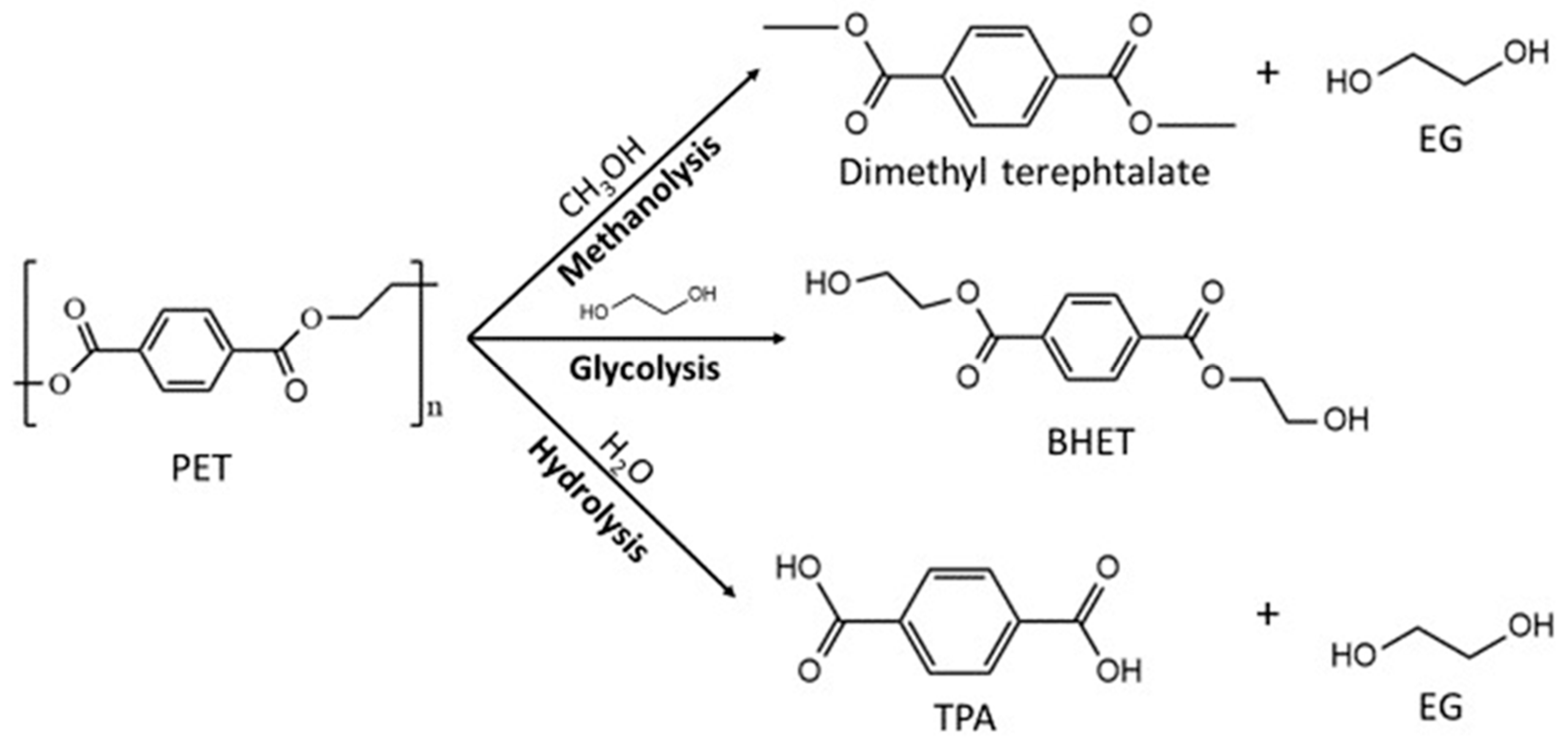
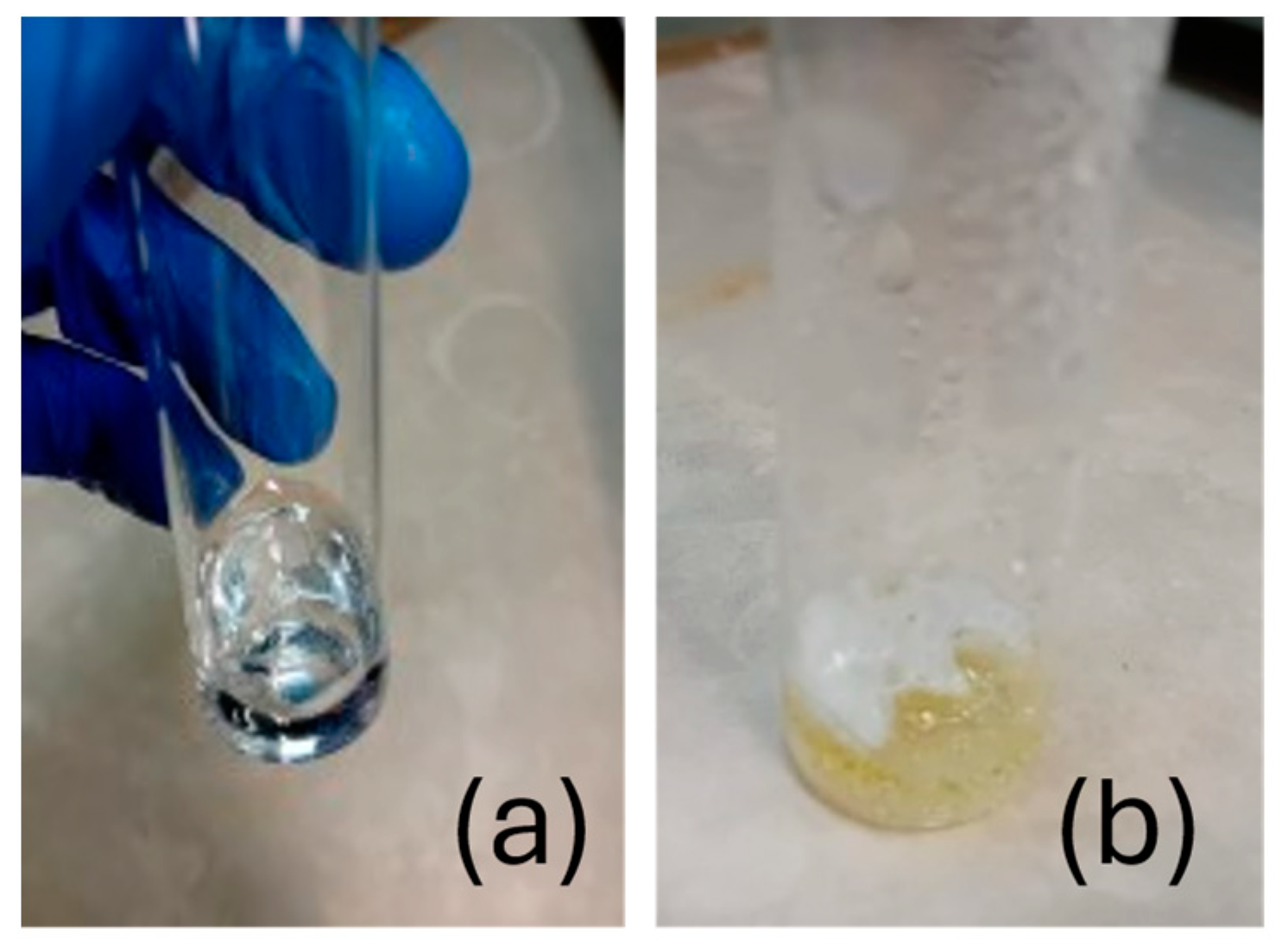
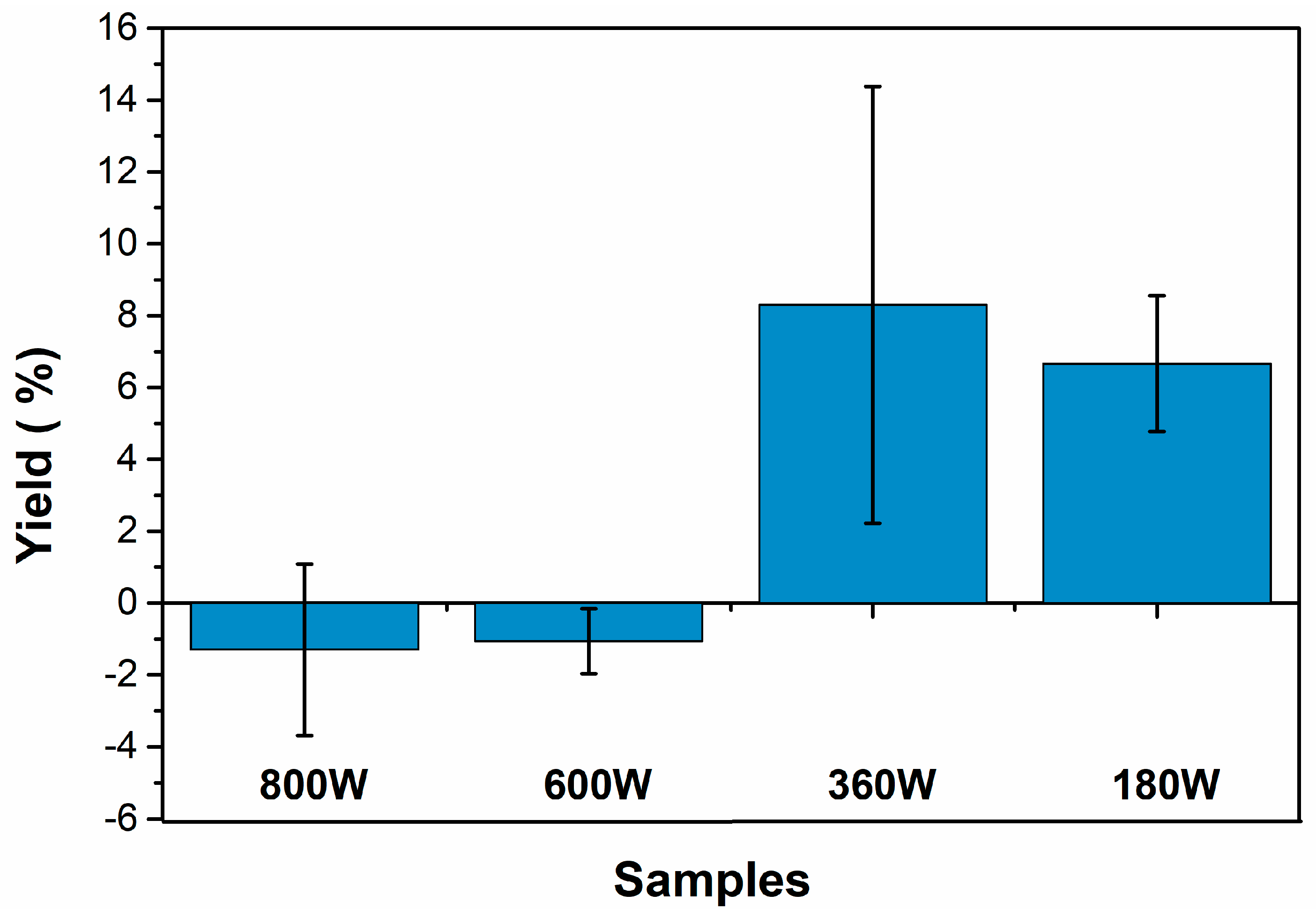
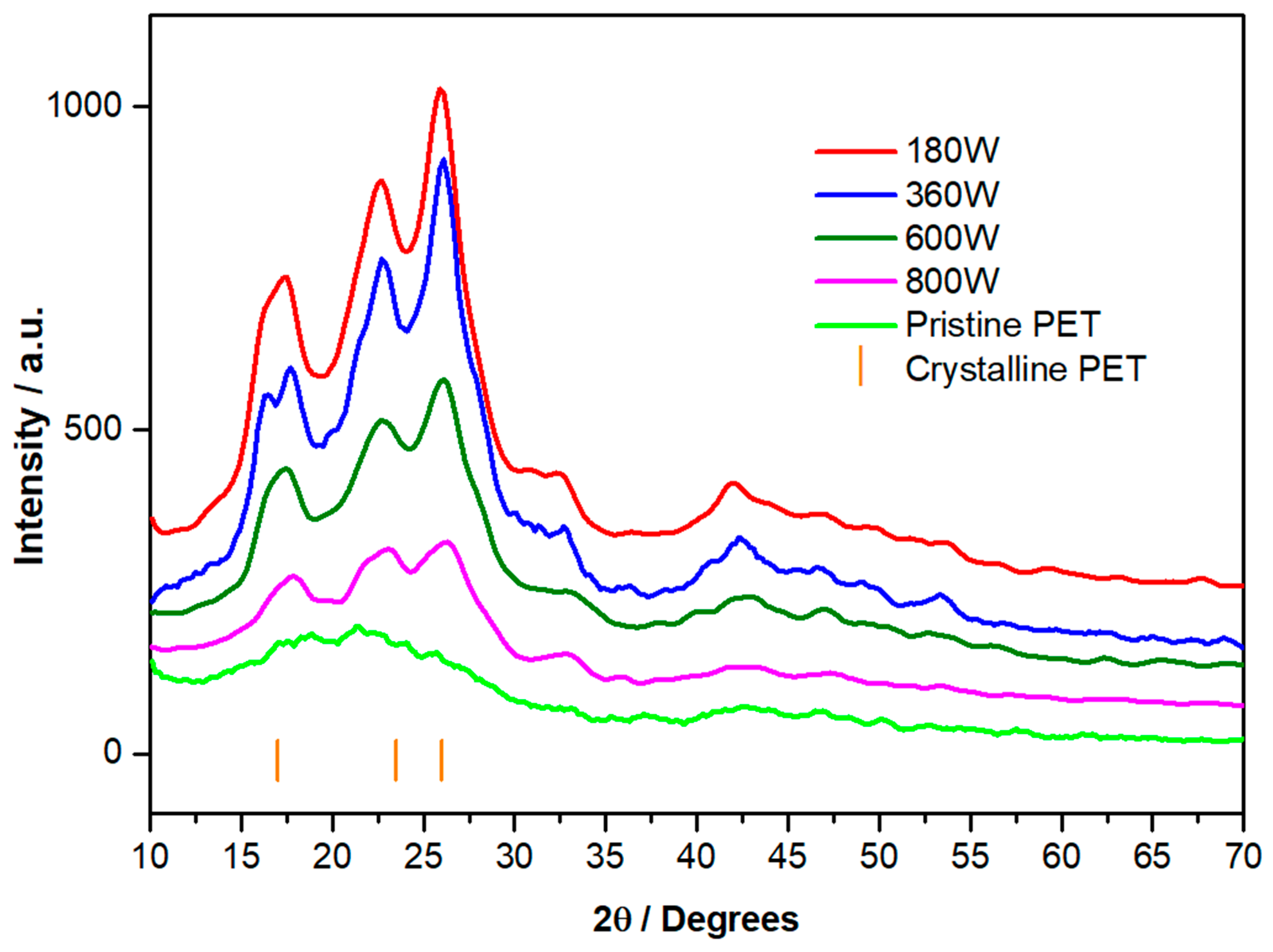
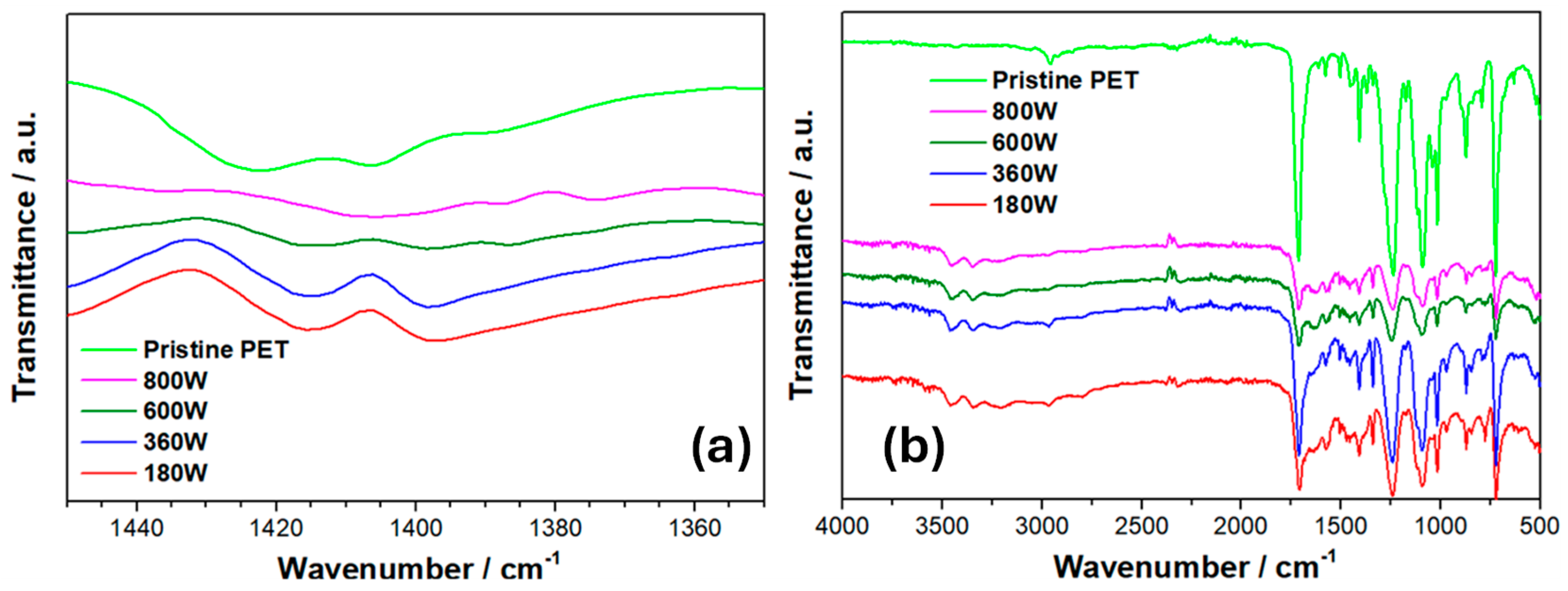

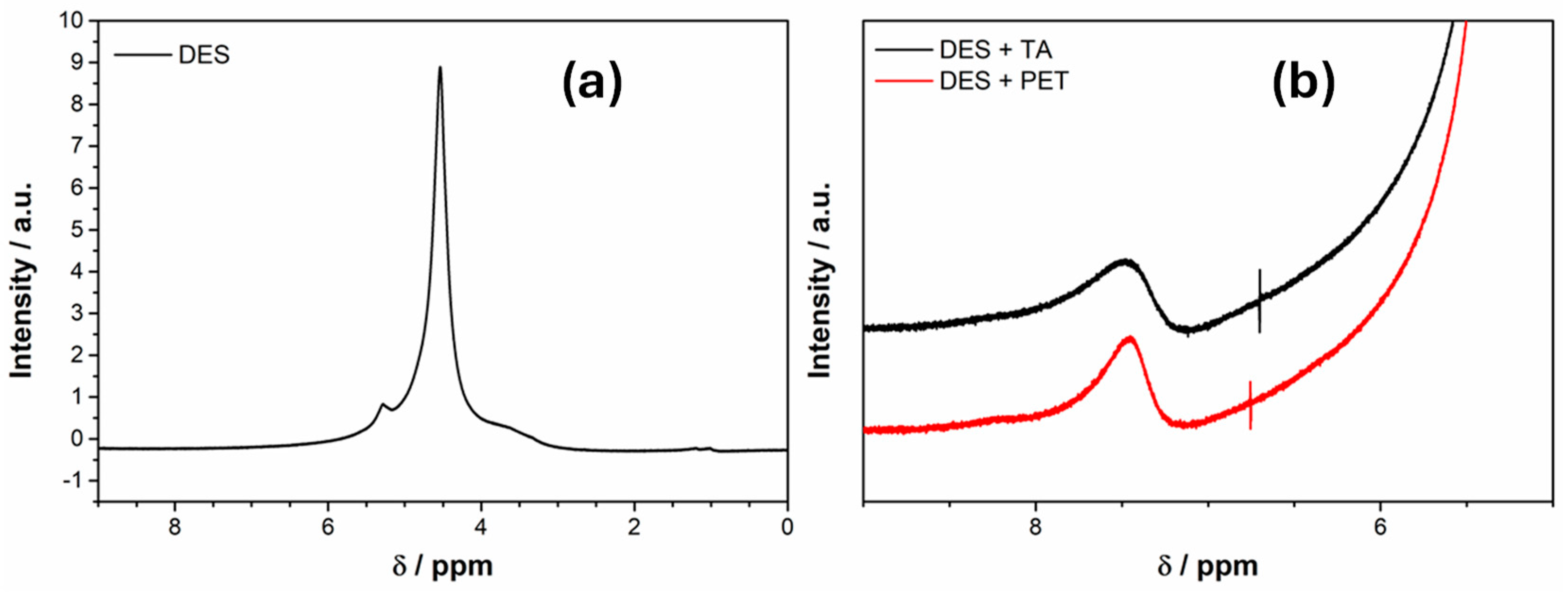
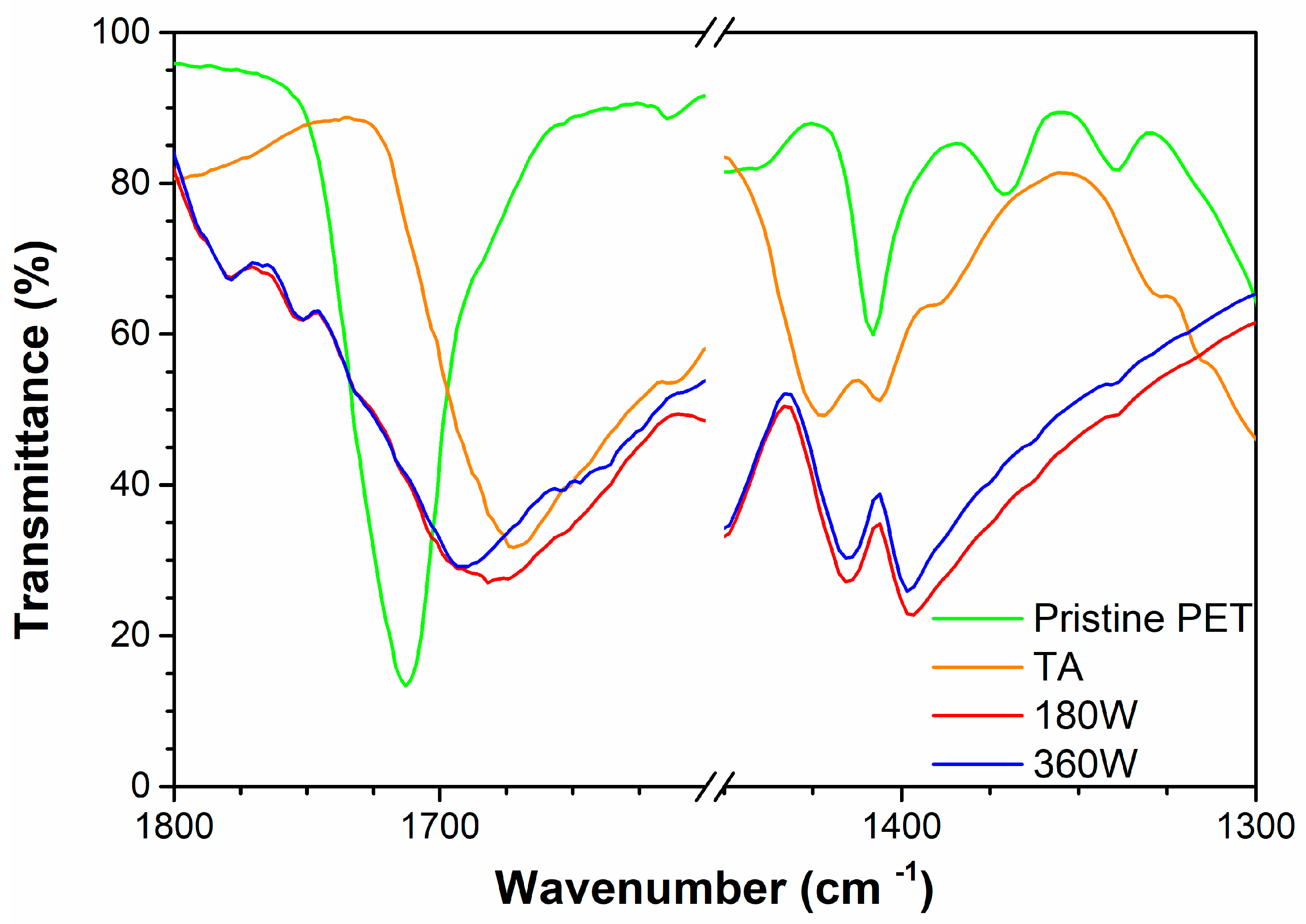

| Power (W) | Processing Time (mm:ss) |
|---|---|
| 800 | 00:30 |
| 600 | 00:40 |
| 360 | 01:10 |
| 180 | 02:10 |
| Observed Signal (cm−1) | Assignment |
|---|---|
| 2956 ms | CH2 methylene stretching |
| 2018 vw | CH2 methylene stretching |
| 2048 vw | CH2 methylene stretching |
| 1712 vs | C=O carbonyl stretching (ester) |
| 1614 w | C=C ring stretching + =C-H ring in plane bending |
| 1577 mw | C=C ring stretching |
| 1504 mw | =C-H ring in plane bending + C=C ring stretching |
| 1452 m | CH2 methylene bending + O-CH bending |
| 1408 s | C=C ring stretching + =C-H ring in plane bending |
| 1370 w | CH2 wagging |
| 1338 w | CH2 wagging |
| 1267 shoulder | C-O stretching carbonyl + =C-C ring ester stretching + C=O in plane bending |
| 1238 s | |
| 1172 w | =C-H ring in plane bending + C=C ring stretching |
| C-O stretching carbonyl + C=C-C ring bending + C=O in plane bending + O-CH2 stretching | |
| 1116 s | C=C ring stretching + C-O carbonyl stretching |
| 1090 s | C-O stretching carbonyl + C-C glycol stretching + C-C-O glycol bending + C-O-C bending |
| 1041 m | C=C-C ring stretching + C=C ring stretching + =C-H ring in plane bending |
| B 972 w | -O-CH stretching + C-O-CH2 stretching |
| 875 m | =C-H ring out of plane bending + =C-C ring ester out of plane bending + C=O out of plane bending + ring torsion |
| 843 w | CH2 rocking |
| 792 mw | -C=O out of plane bending + ring torsion + =C-C ring ester out of plane bending |
| 723 s | =C-H ring out of plane bending + -C=O out of plane bending |
| 632 vw | C=C-C ring bending + =C-C=O ring ester bending |
| 497 m | =C-C=O ring ester stretching + C=O in plane bending |
| Observed Signal (cm−1) | Assignment |
|---|---|
| 1712 vs | PET C=O carbonyl stretching (ester) |
| 1692 s | 180W C=O carbonyl stretching |
| 1678 s | 360W C=O carbonyl stretching |
| 1671 s | TA C=O carbonyl stretching (acid) |
| 1423 s | TA C=C ring stretching + C=C-C ring stretching |
| 1415 s | 180W C=C ring stretching + C=C-C ring stretching |
| 1415 s | 360W C=C ring stretching + C=C-C ring stretching |
| 1408 m | PET C=C ring stretching + =C-H ring in plane bending |
| 1405 m | TA C=C ring stretching + C=C-C ring stretching |
| 1397 s | 180 W C=C ring stretching + C=C-C ring stretching |
| 1397 s | 360 W C=C ring stretching + C=C-C ring stretching |
| 1370 | PET CH2 wagging |
| 1340 | PET CH2 wagging |
Disclaimer/Publisher’s Note: The statements, opinions and data contained in all publications are solely those of the individual author(s) and contributor(s) and not of MDPI and/or the editor(s). MDPI and/or the editor(s) disclaim responsibility for any injury to people or property resulting from any ideas, methods, instructions or products referred to in the content. |
© 2024 by the authors. Licensee MDPI, Basel, Switzerland. This article is an open access article distributed under the terms and conditions of the Creative Commons Attribution (CC BY) license (https://creativecommons.org/licenses/by/4.0/).
Share and Cite
Ricci, C.; Gontrani, L.; Bauer, E.M.; Ciufolini, G.; Lembo, A.; Casoli, L.; Carbone, M. Metal Ion Microwave-Assisted Depolymerization of Poly(Ethylene Terephthalate): A Zinc Salts-Based Deep Eutectic Solvent as Case Study. Crystals 2024, 14, 567. https://doi.org/10.3390/cryst14060567
Ricci C, Gontrani L, Bauer EM, Ciufolini G, Lembo A, Casoli L, Carbone M. Metal Ion Microwave-Assisted Depolymerization of Poly(Ethylene Terephthalate): A Zinc Salts-Based Deep Eutectic Solvent as Case Study. Crystals. 2024; 14(6):567. https://doi.org/10.3390/cryst14060567
Chicago/Turabian StyleRicci, Cosimo, Lorenzo Gontrani, Elvira Maria Bauer, Giorgia Ciufolini, Angelo Lembo, Lorenzo Casoli, and Marilena Carbone. 2024. "Metal Ion Microwave-Assisted Depolymerization of Poly(Ethylene Terephthalate): A Zinc Salts-Based Deep Eutectic Solvent as Case Study" Crystals 14, no. 6: 567. https://doi.org/10.3390/cryst14060567





